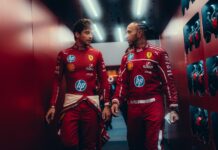How did a flourishing Red Bull F1 junior programme come to a situation where they had to take in Sergio Perez, FormulaRapida.net looks at their situation.
Recent events concerning the Red Bull Junior programme have raised vastly more questions than answers. The programme was highly praised when they found the next wunderkind in Max Verstappen but in the time since then, they have struggling to find the next talent to supplement the Dutchman.
Among their current crop of talent, they’ve promoted Japan’s Yuki Tsunoda – who is also backed by Honda – to an F1 seat for 2021 with AlphaTauri (formerly Toro Rosso). Also in their talent program are Juri Vips (F2), Jehan Daruvala (F2), Liam Lawson (F3), Jak Crawford (F4), Dennis Hauger (F3), Jonny Edgar (F4), Jack Doohan (F3), Igor Fraga (F3) and Ukyo Sasahara (Super Formula). The list awaits reaffirmation for 2021.
Despite having this array of talent, the team were forced to select Sergio Perez for the 2021 F1 season, who was drafted into Red Bull to replace the forsaken Alexander Albon. The announcement marked the first time that they have picked up a driver from outside their ranks since the 2007 season.
This situation, however, isn’t the making of today. Rather, it was upon Sebastian Vettel’s departure from the Milton Keynes team that flaws in their program came to light. From 2010-2013, Red Bull were on a definitive high with the German and Mark Webber, as the team clinched four championship titles in a row. That pairing’s presence in the team meant that the programme’s other drivers within the sport were relegated to positions at Toro Rosso.
Once Vettel was promoted to Red Bull in 2009, he denied Sebastien Bourdais an opportunity, the Frenchman having been his teammate at Toro Rosso. While the German and Webber serially clinched titles, the careers of Sebastien Buemi and Jamie Alguersuari got stuck as well. Despite promising form displayed by the two, neither had any chance to try their hand at the senior outfit.
Vettel’s promotion also left Antonio Felix da Costa at sidelines, the Portuguese driver never even getting into F1 – something which Christian Horner admits shouldn’t have been the case. Having raced for Toro Rosso for three seasons, both Buemi and Alguersuari, sadly, had to make room for youngsters like Daniel Ricciardo and Jean-Eric Vergne.
With Webber coming to the end of his term, it became a straight fight between Ricciardo and Vergne, with the former beating the latter to a Red Bull seat in 2014. A blow to the Red Bull program came towards the end of that season when Vettel decided to leave the team to join Ferrari. This left them in a fix, although Vergne was one of few to be delighted with the news.
With Vergne an ostensible shoo-in for the seat, Red Bull surprised everyone with their decision to fast-track Russian Daniil Kvyat from Toro Rosso to the senior F1 outfit, after only one year for Kvyat in the junior team. The Russian had already skipped GP2, as Red Bull decided to hurriedly force him into F1 after he took the GP3 title in 2013.
What looked like a bold move only prompted the downfall of the Red Bull programme, leading them down a path of stories all-to similar to that of Kvyat. Both Red Bull drivers got off to a strong start in 2015, though they lost two places in the F1 constructors’ championship. The disorder of Red Bull’s operation in 2015 proved an augury for what was to come in 2016.
Toro Rosso drafted in a new line-up in the former year, with Carlos Sainz joined in the junior team by Verstappen – another driver to have been fast-tracked, arguably even quicker than Kvyat. The Dutchman only had his first year in European F3, where Dr. Helmut Marko spotted him, and swiftly awarded him an F1 drive.
He bypassed not only a proper F3 run but also GP2/F2, which raised the collective eyebrows of the paddock. He didn’t disappoint, though, as he managed to beat Sainz – who completed the junior run – in the drivers’ standings in 2015. The Spaniard was a solid performer, but the drives from Verstappen were received yet more positively.
Despite expectations to the contrary, Red Bull pulled the plug on Kvyat the moment they got an excuse, and enlisted Verstappen in the senior team’s roster alongside Ricciardo. The Dutchman only made things better for them after winning on his debut with the senior outfit in that year’s Spanish GP.
Though Verstappen’s success story reflected positively on Marko’s program, the Austrian had left drivers like Kvyat and Sainz in a spot of bother. Despite the Dutchman’s supreme showing, personally, I was never in agreement with such a move – regardless of whether or not the Russian had lost his way. It just seemed unfair to myself and to many.
This one move affected a host of other F1 drivers in the Red Bull camp as the fear of ruthless consequences for any poor performance impacted the performances of certain others – it also created an undue public pressure by the form of social media. The pressure demolished Kvyat then as Red Bull were forced to bring in former junior Brendon Hartley, with no other junior to step up straightaway.
Hartley’s promotion came after Kvyat was dropped to Toro Rosso with shaken confidence, and a year later in 2017, his performances were indicative of an anxious driver. While the drama around the Russian ensued, this move pushed Sainz into looking drives outside the programme. The Spaniard struck a deal with Renault and moved in, replacing Jolyon Palmer.
At that time, it did not appear as though the Spaniard was gone for good, but this came to fruition in 2018, just when Ricciardo decided to not renew with Red Bull. The Australian’s departure delivered a crushing blow to the programme, with two of their high-end drivers, both of whom could have partnered Verstappen, dropping out. The duo had done to Red Bull, what Red Bull had done to their drivers.
The spiral which started with the fast-track move of Kvyat continued as they had three solid drivers out of their programme for F1 2019. It forced them to promote Pierre Gasly, despite reservations due to his inexperience. The hope for another ‘Verstappen-like’ performance didn’t pay off, with the Frenchman struggling that year, and his difficulties apparent as early as winter testing.
With the Frenchman at Red Bull, Red Bull were forced to re-sign Kvyat at Toro Rosso and bring in another former junior Albon, who had already signed a Formula E deal with Nissan. The Thai driver replaced Hartley, who was left high and dry after one and a half years.
Such was Gasly’s lack of pace that the now-24-year-old was eventually replaced by Albon midway through 2019. Yet despite repeated instances of rushed promotions failing to deliver, hope was same yet again. At first, Albon’s promotion appeared a reasonable move, but in 2020, his lack of experience started to hamper the team.
The Thai driver remained at the team until the end of the season, helped by the lack of available talent in the team’s programme. But with Albon unable to match the in-form Verstappen, his ouster became apparent with a driver like Perez in the market. They have retained the Thai as a reserve, but it will be a difficult road for him to return, judging by the previous experiences where no one made it back to the senior team after their drop.
At the same time, they will be looking at Tsunoda to help them ticking with new talent and not force them to fall back on tested drivers. While the Red Bull programme has helped in shaping up careers of many drivers, in recent times, it has been detrimental to their own team, where they have struggled to balance the performance level.
It is clear that Verstappen is looked upon as the leading driver, not just of his experience and or stature but most importantly, for his results. The raw talent helped him remain at Red Bull, even though he took nearly two years to settle himself in and deliver consistently. The 2018 Monaco GP incident was the eventual turning point in his career.
While Verstappen got an extended run, the same cannot be said for Kvyat, Gasly and Albon – granted that Red Bull has more data to understand, who can deliver. Amazingly, the Ferrari programme has become a benchmark not long before the Verstappen’s arrival, especially because it is not rushing in and giving drivers the time required to flourish.
The added pressure of a mid-season swap and fast-track is not helping their programme to deliver the kind of drivers they require. At the end of the day, Verstappen is once in a lifetime talent, he can be a benchmark, but in the quest to fulfil that, it has repeatedly failed, where they have lost five drivers in the form of Kvyat, Ricciardo, Sainz, Gasly and Albon.
It is interesting and ironic that Red Bull’s problem started with Vettel leaving and got exacerbated by Verstappen’s arrival, but the Dutchman is seemingly the solution to it as well, because he is a rare success story of the programme’s pattern of rushing drivers to the top of motorsport. It will be to see if they continue the pattern or take corrective measures.
Here’s Daniil Kvyat on experience lack troubling his initial F1 run
Additional writing/editing done by Duncan Leahy



















